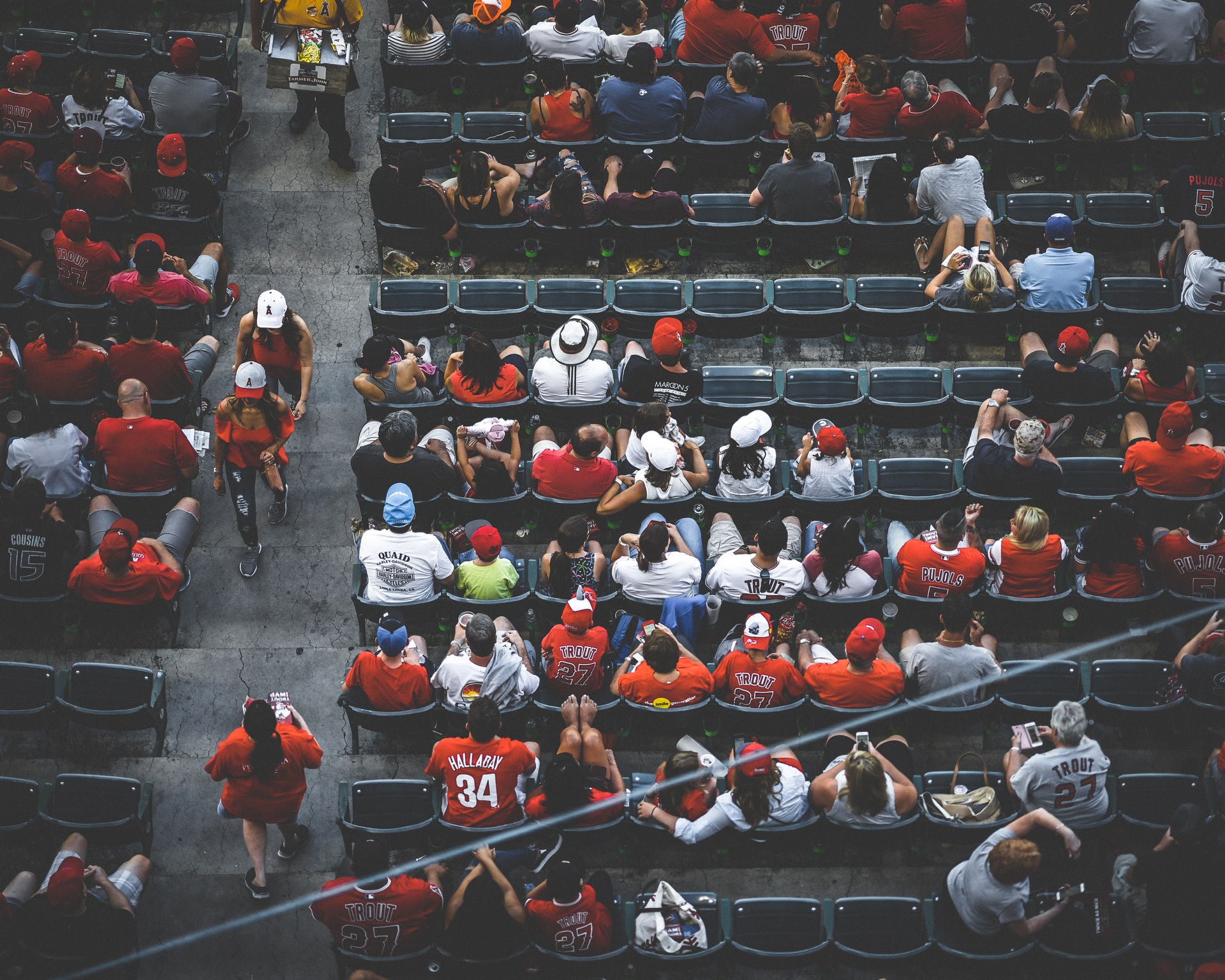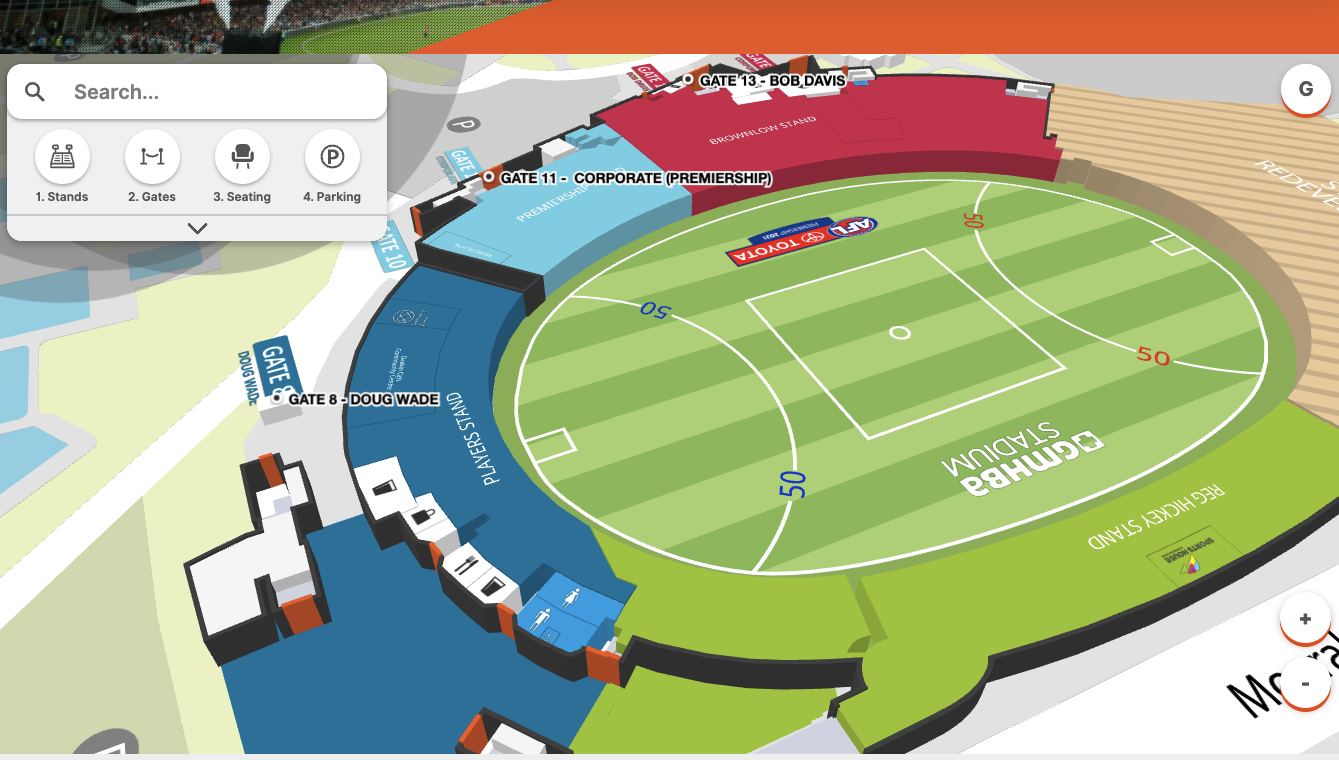Your guide to location-based marketing in stadiums. What is it, how does it work, getting started with marketing tactics, how to gain valuable insights, and how Mappedin can help.

What is Location-Based Marketing?
Location-based marketing is a tactic that utilizes a person’s physical location to target them with personalized messages. Using past and real-time location data, marketing teams can reach consumers based on qualifiers such as proximity to a store, major events happening within their area, and more. For instance, you could target mobile app users and motivate them to make purchases at concession stands or apparel shops around the stadium or arena. Similarly, a sports team may advertise their marketing programs and on-site offers that would entice fans to participate, increasing both user engagement and the fan experience.
How Does Location-Based Marketing Work for Stadiums?
Stadiums can use available widely available indoor positioning and geolocation technology including beacons, wi-fi, RFID, and geomagnetic, to understand the real-time position of people as they navigate the indoors. Two key requirements are needed to have a functional and successful location-based marketing strategy. The first is an understanding of a user’s current location through positioning layered with a digital venue map, and the second is that users must opt-in to receive notifications and have location services enabled before businesses can send promotional alerts and messages.
The Importance of Location-Based Marketing for Stadiums
Location-based marketing is being used effectively as a powerful strategy for stadium marketing teams to increase user experience, fan engagement, and customer retention through discovery and brand awareness campaigns. Driving relevant and timely location-based campaigns allows stadiums to capitalize on the immediate purchasing decisions of target audiences. Stadiums are constantly looking for ways to send personalized offers and premium content to the fan experience, whether it is to build brand awareness or promote time-limited offerings.
Why Stadiums Should Use Location-Based Marketing?
Stadiums and sports venues have tremendous amounts of foot traffic for sporting events and concerts. Location-based marketing can help drive revenue by increasing foot traffic to vendors spread around the stadium by informing visitors with targeted and special offers using personalized messaging.
Stadiums that use location-based marketing create a better customer experience by targeting customers when they are likely to purchase or require products and services. Campaign timing and distribution both play a vital role in only serving relevant messages and notifications at a time when it is most impactful. For example, an effective marketing angle could be when a team reaches a target statistic (such as scoring more than five goals), a special offer is enabled and can be sent to attending fans through a mobile app.

Benefits to Location-Based Marketing for Stadiums
Low-cost and highly targeted messaging
Mobile devices are a necessity for location-based marketing at stadiums. According to eMarketer, in 2021, 88% of adults own a smartphone. Investing in a location-based marketing platform can have a low cost compared to how many highly targeted messages are sent. This provides a high return on investment for a relatively low cost.
Boost business during quieter times
In the middle of the sports season when attendance dips? With location-based marketing, send discounts and offers to improve fan loyalty and customer engagement. Promotional deals or relevant ads can be a great way to convert merchandise purchases.
Increase engagement using campaigns
In the busiest times of the sports season? Build brand awareness for consumers through outreach campaigns like connecting your social media stories or targeting specific demographics with personalized messaging.
Disadvantages of Location-Based Marketing
Requirements to Opt-in
A user must opt-in their location data through a web or mobile app. This can be a disadvantage if users don’t want to opt-in or don’t own a smartphone.
Targeting Inappropriate Demographic
If a user’s profile is incomplete or inaccurate, the user is at risk of receiving an irrelevant or inappropriate marketing message.
Ineffective Data Location
Location accuracy plays a big factor in location-based marketing. There’s a chance location data will vary and depending on the methods used to calculate your location, it may be ineffective or may miss timing relevant messaging.
What Do Beacons and Geofences Provide to the Sports Teams?
Beacon and geofence technology influences customer behaviour and sales strategies during sporting or major events. Partnering with sports teams using location-based technologies, merchandise stores, food vendors, and brand marketing teams can enhance the fan experience through customer loyalty campaigns, collect customer behaviour data, and provide a platform for promotions and offers to entice fans to make purchases.
Beacons improve location accuracy inside stadiums and have many uses including personalization and assistance. Beacons can be used to personalize the customer experience through a mobile app. For example, if it’s a sports fan’s first-ever visit to a game, they could be sent a welcome message. Beacons can also help locate customers who may require assistance. A message can be sent via a mobile app to staff who would receive a push notification and can quickly locate the customer at their seats. With accurate location data, fans could use a mobile app to find the closest food vendor with the shortest lines so that they won’t have to miss much of the game or event.

How to Choose the Best Location-Based Marketing System for Stadiums
Many platforms provide location-based marketing systems for stadiums. These platforms identify when existing or potential customers are within predefined proximity or geofence and trigger the delivery of personalized, contextual marketing content to consumers with smartphones. Here are some things to consider when choosing the right system for a stadium:
Identify a target audience within a specified geographic boundary or within the stadium vicinity through the use of geofencing, wi-fi, beacons, or a similar geotargeting technology
Provide a platform that includes communication tools to deliver scheduled, targeted, and automated messages based on their location
Provide analytics or a dashboard to analyze proximity-based marketing campaign metrics and performance
Allows customers to opt-in and out of marketing communications and updates distribution lists automatically for the Marketing team
What Sets MappedIn Apart?
Mappedin has worked with stadiums and teams such as St. Louis CITY SC to design and build a custom wayfinding experience with our Web SDK that enables maximum discovery of the venue’s services and amenities. Mappedin has also created interactive stadium maps for Kardinia Park and Blundstone Arena.

The Mappedin platform enables stadiums and arenas to build editable digital maps and promote news and updates about live and upcoming events. To implement location-based technology and marketing strategies, one of the first steps is to create a visualization of the stadium, arena, or sports field. By combining precise location data and a digital map, operators can better understand foot traffic, how people move through the stadium, as well as how to use this information to improve the visitor experience.

There are three key components required to build a proximity marketing experience: the advertising content, positioning, and the digital map. Mappedin’s blue dot navigation feature takes care of the second piece for marketers hoping to target attendees to a sporting or entertainment event.
Location-Based Marketing for Stadiums FAQs
What Types of Location-Based Marketing Are Available Today?
There are four main types of location-based marketing. Here’s a brief overview:
Geofencing: Send personalized messages or location-based notifications using a customer’s real-time location. For example, if you have a restaurant chain’s mobile app and opted-in, you’ll receive a message when you’re near one of its locations.
Proximity marketing: Similar to geofencing, but using proximity technology such as beacons, wi-fi, or near-field communication (NFC). Deliver alerts to mobile users on their smartphones or nearby devices when they are within a defined distance of a location.
Geotargeting: Advertising is served to audiences that visited specific locations in the past. For example, anyone who visited the stadium in the past 30 days is entered into a campaign that’s relevant to that audience.
Geoconquesting: Connect with audiences by sending them affordable offers when they attend competitive locations. This strategy works best for customers who are ready to make an immediate purchase.
How Do You Advertise in a Stadium?
Location-based marketing for stadiums is often created as part of an overall marketing plan that encompasses several tools and smaller strategies together. Part of it is to integrate a user engagement platform to segment users, create campaigns, and define geographic boundaries. Incorporating location-based marketing requires an investment in different technologies, from marketing expertise to indoor mapping and more. An indoor mapping provider is your best bet for optimal results.
They’ll have the expertise necessary to create and automate your indoor maps, as well as integrate your existing software tools and APIs with their mapping solution. For example, a stadium could offer a limited-time discount on their scoreboard or TV displays using a scannable QR code. Fans who are able to scan the code can be provided with turn-by-turn directions to that vendor wherever they are in the stadium. Figuring out how many customers take advantage of these promotions can provide key insights into their behaviour.
How Effective Is Location-Based Marketing for Stadiums?
Assess the needs of your customers (and potential customers) and think about the creative location-based marketing solutions that may resonate with them. It can be very effective for creating emotional connections. If your ad or offer resonates very well with a fan, they will remember that and likely be a repeat customer or recommend it to a friend.
Interactive maps on the web or integrated into an app can help users navigate to areas of interest around a stadium through social media stories or QR codes displayed throughout the venue. Stadium operators can review location insights and analytics to gain a better understanding of how visitors move throughout the venue and ultimately improve the wayfinding stadium experience for visiting customers. To get started, contact us.
You may also like
Blue Dot Navigation For Stadiums
How can you use blue dot navigation in your stadium or arena to deliver an unforgettable fan experience? Keep reading to find out. What is Blue Dot Navigation? Blue dot...
Stadiums
Article